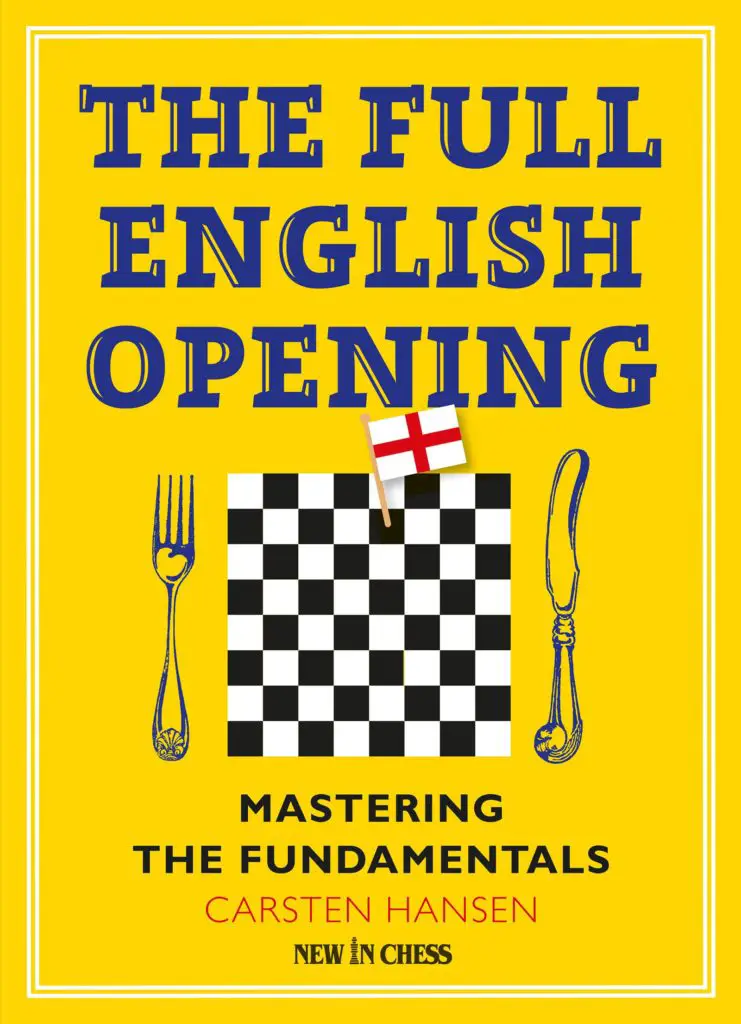English Opening: (Basics, Variations, Benefits and How to Counter)
⭐⭐⭐ Take 8 minutes to read and improve your chess game ➡️ : This article was first published on, and is Copyright of Chessquestions.com
There are many openings for white in chess and this guide is around one which is slightly different but no less effective using 1.c4 as the first move instead of the King or Queen’s pawn as the first move.
The Ultimate English Opening (1.c4) Guide
In this post, I will introduce you to the Ultimate Guide to the English opening if you have no idea what it is as a new chess player.
If you have found this English Opening article through searching google, for more information, the article will provide the basic moves, how to play it, variations and of course how to counter the English opening if you are playing the black pieces.
Is 1.c4 a good opening for Beginners?
I think it is fair to suggest that the English chess opening might be suited more to intermediate and more advanced players.
This is not because it is difficult to learn, but rather, central pawn openings form the basis of learning opening theory as a beginner and should be the focus before moving on to flank openings such as 1.c4
1. c4 is a good opening to learn and compares to d4 and e4; it all depends on the kind of middlegame you’d want to play but be aware that from a positional nature, there is a lot more to learn by opening with this pawn.
There are a total of 20 possible first moves for white in chess and 1.c4 is in fact the second strongest opening after the Queen’s pawn opening of 1.d4 and slightly better than the 1. e4 King’s pawn opening when looking at the balance of the game after one move.
But we are not considering the game balance after a single move here, there is much more to do to gain an advantage in the chess game than move a single pawn.
What does c4 mean in chess?
c4 in chess is a grid identification for a particular square on the chess board in chess notation.
I regret to say that if that answer is required to that question at this stage of your chess education, this opening is not going to be for you, and I would suggest heading to my post on the numbers and letters on a chess board guide first before you start playing the English Opening.
Get familiar with that, learn some chess notation and perhaps a couple of these openings for white in chess, and maybe come back to the English at a later date.
Top 3 Advantages of Playing 1.c4
- Even those 1.c4 is off-center, it does fight for early central control from a slightly wider position, especially when backed up by central pawn development and knight support
- The english opening is ideal for queenside pressure on black and restricting options for your opponent when played well.
- At beginner level or lower intermediate level, many black players are not prepared for a flank pawn opening when they play chess and may not have faced it often enough to understand the optimum moves to counter it.
Top 3 Disadvantages of Playing 1.c4
- You will find you have slower central development as white playing the English opening, but often transposition to other openings transpire to steady your center.
- Attacking chances from a direct perspective become a little more limited, but again, with practice and understanding this can be overcome, but you will have a slower game on your hands.
- White gives the opportunity for black’s e-pawn to take 1…e5 which is a rare chance and develops the King’s English opening.
English Opening: Basics and Key Concepts
The Moves:
1.c4
That’s it, the second you move your c pawn 2 squares forward you have initiated the English opening in this game of chess.

There are a couple of extensions of this, including the symmetrical English and King’s English variations which I will cover shortly but the basic opening will often be found transitioned into other chess openings by achieving similar positions but from a different order of moves.
It has been and continues to be played by a number of grandmasters including Garry Kasparov, and even Bobby Fischer who was the greatest 1. e4 opener of all time and loved the move was known to play 1. c4 on occasion.
English Opening from GothamChess
The best chess YouTube channel by far, take a look at this 10 minute guide to the English Opening from Levy Rozman
English Opening Variations
You will find that whilst each opening might have a name, it is not limited to a specific set of moves, there are different lines based on how black plays against you, so there will be variations upon the theme, So let’s take a look at the main lines.
Symmetrical variation
Moves
1 c4 c5
You probably had already guessed by the name that the Symmetrical English is simple Black countering with c5 and setting up a symmetrical board.

This is arguably the best response to 1. c4 on balance and can lead to further openings including the four knights symmetrical variation of the English where the Knights develop behind the c file pawns.
Another symmetrical option is the development of the g file pawns before the second knight emerges and then fianchetto of the kingside bishops. This is the ‘ultra-symmetrical line’ of the English opening.
King’s English Variation
Moves:
1 c4 e5
Here black counters with an immediate take of the strong e5 square with the King’s pawn moving two squares forward to gain a rare opportunity to get to this square without the threat of quick capture.

Black’s position benefits from taking control of e4 here and building a strong center for quick development.
by not playing the symmetrical c5, black does allow white to continue to develop and dominate the queenside of the board.
Benefits of playing the English Opening
The English Opening is a powerful way to start the game for both positional and tactical players. The game’s opening also lets players deceive their opponents by changing into other main-line openings.
The English Opening is an excellent choice for aggressive players who want to adopt creative strategies rather than memorize complex theory which is one reason that more advanced players will experiment with it. The English Opening can be full of ideas and can be less rigid than 1. d4 and 1. e4
How to Counter the English Opening successfully
So now you know the English opening from the white side, it is important to consider what to do when playing black and suddenly seeing that flank pawn move instead of the expected central pawns.
Don’t let your opponent take you by surprise with this opening, be prepared and understand your optimum response choices to counter the English opening.
Black’s Top 5 Responses to a 1.c4 Opening Question
There are not really a top 5 responses to the English, unless you are really smart, you only have two real options.
- 1…e5 for the King’s English Variation or.
- 1…c5 to begin the symmetrical line
The next best 3 options would be 1…e6, 1…Nf6 or 1…Nc6, all of which will lead to white taking the d4 square on move 2
1…e6 is the Agincourt defense and just invites 2. e4 transposition to Queen’s pawn opening for white which cedes central control from the get go.

You’ll almost certainly be following up with the King’s bishop b4 check Keres defense, which in turn is a certain exchange of bishops, from which things remain relatively level but you are behind in development and will need to play a safe 4. Nf6 or further exchange in the middle with 4.d5

1…Nf6 Anglo Indian Defense
With the Anglo Indian you are again inviting the d pawn 2. d4, slowing your development as 2…e6 is by far your best option in reply. From here white will develop with a Knight – If Queenside 3. Nc3 play 3…d5 or if 3. Nf3 play 3…b6

1…Nc6 Anglo-Lithuanian Defense
Once again, we will see play d4 to take the center, where your best response would be e6 which is the Mikénas defense to the Queen’s Pawn Opening into which we have now transposed, white will play 3. Nc3 whereby your best option is to go threaten the Knight and expect 4. e3
Play 4…Nf3 for the Nimzo Indian Defense, Taimanov Variation (ECO E40)

How do you crush the English opening?
The very best trap I have seen in the English opening is a sweet queen sacrifice trap and pawn break, that white will almost certainly not be able to resist falling into.

Frequently Asked Questions About the English Opening in Chess
What is the goal of the English opening?
The goal of the English chess opening is to apply pressure on the center d5 square without committing the queen pawn or the king pawn too early, whilst having the flexibility to transpose into other openings easily and catching the opponent unaware of your strategy
Is the English an aggressive opening?
The English opening does set up a slower developmental game in some way but with easy transposition options to other openings and control of the d5 square there can be aggressive exchange set up in the center of the board
Is English Opening chess good?
If you are a positional player or like to experiment with opening tactics the English opening is good because of the flexibility it offers to respond to the black pieces counterplay, often pushing the opponent out of position and applying pressure on the queen side.
Does the English Opening have a lot of theory?
The beauty for tactical players is that there is flexibility for experimentation outside of 1.d4 which in turn leads to a lot of serious opening theory in the English game that can either be embraced although it is not essential if the plan is to transpose to another opening of which theory is already well-learned.
Is the English Opening the Same as the London System?
The English opening and the London system are not the same and differ in the very first move as the London is 1. d4 as opposed to the English Opening of 1. c4
English Opening Story
I always loved playing chess. As a kid, I would spend hours each day studying the game and trying to improve my skills. By the time I was in high school, I was one of the best players in my year.
One day, I came across a book that talked about the English opening. This was a new opening to me, so I decided to give it a try. It took quite some time to hone my skills in playing it but while my opponents would often be caught off guard, to begin with, I rarely seemed to be able to make the most of my early position.
Over time, I studied these games and in particular my opponent’s moves and I began to find that defending the English opening was easier than playing it as an opening.
These days, I still often play the English opening from time to time, but when playing the black pieces, I find I am well prepared not only to defend against it but aggressively attack it with a better than 50% success rate. It remains one of the few openings I have that win rate against as Black.
English Opening Books
Most chess players only ever learn a limited number of openings, and this can often lead to problems when they come up against an unfamiliar opening.
If you want to be a well-rounded chess player who is comfortable in any position, then you need to know the English Opening. This versatile opening can be used against any type of opponent, in any tournament situation.
‘The Full English Opening’ is the first one-volume book that covers all variations. With this book you will have a complete understanding of the English Opening and will be able to play it with confidence against any opponent.
Conclusion
The English Opening is best left alone by beginners and is more suited to intermediate and advanced players. The opening varies in character from aggressive to slow and positional, but generally, it’s recommended for the player who prefers a slower game with tactical opportunities. This chess opening can be played against any of Black’s responses as White (1…e6, 1…d5 or 1…Nf6), which translates into flexibility for experimentation outside of 1. d4 openings that are well-known theory wise.







